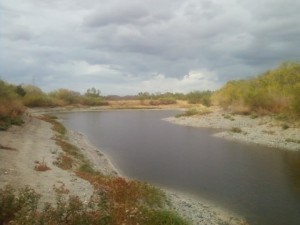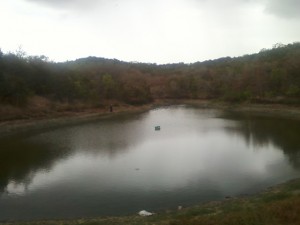The Travis County metropolitan park system is an odd mish-mash of recreational opportunities. These parks have ball fields and playscapes like a city park, but they also have hiking and semi-wilderness areas. The Southeast Metropolitan Park is located close to the airport, but still a fair distance from civilization. I sometimes visit there when I make trips to the airport, or when I’m waiting for a late flight to arrive.
If you’re interested in fishing, you will want to make the first right from the entrance. This leads you around the vast stretches of softball fields and out to the forest at the back of the park. They close the gate to this section at sunset, and a county park ranger zips around the trails on his utility vehicle gathering up the dawdlers (such as myself for instance).
There’s a startling change in terrain when you get on the hiking trails. The park drops down into the Colorado River valley through a dense forest of cedar. If you keep your eyes open you might see some deer and foxes. There’s also a great view of the City of Austin wastewater treatment plant, which looms out of the valley below like a particularly sanitary Mayan pyramid.
The trails go up and down steep hills for about a mile before you get to the park’s three hidden ponds. The park ranger who picked me up in his utility vehicle at sunset and gave me a quick fisherman’s tour of the area told me that the ponds have catfish and one or two lunker bass, but all I’ve ever seen are the usual panfish.
I took the Big C out to this park late last summer, when Fishing Team was having a dry spell caused by the dry spell. The first of the ponds we visited was ringed by six feet of cracked mud left behind as the pond dried. The mud looked like the landscape of a desert, where the earth had hardened into concrete. Looks however can be deceiving, as I discovered once I tried to walk on it, and my foot sunk up to the knee in sticky gray clay. Then I had to reach down the hole left by my leg, about armpit depth as it turns out, to fish out my croc that was left suctioned at the bottom. And what was most aggravating about the incident was that I couldn’t wash off any of the sticky gray clay, because the only water in sight was protected by a no-man’s land of sticky gray clay.
The water of this pond glowed a distinct chemical blue, and despite our best efforts we couldn’t detect any sign of life.
The Big C had some good luck at the next pond down. He caught a series of perch on spinners and live bait, while I struggled to get a strike with the fly rod and poppers.
And that’s when it started to rain. The first rain in months, and it chose the moment when we were a mile deep in a forest.
At first we tried to shelter under the covered fishing pier on the third pond, but the wind made a mockery of that effort to stay dry, so the decision was made to make a run for the car.
This was when we discovered that the well-manicured, mile-long hiking trail back to the parking lot was actually composed of the same sticky clay as ringed the first pond. It was simply of a different color and had needed a modest influx of water to make the transformation from hard surface to squishy mire.
Every step we took caused more mud to stick to our feet. For a while I tried walking on tufts of grass growing on the edge of the trail, but there were precious few of them, and after a few hundred feet I had reached a terminal muddiness that belied further efforts to stay clean. The Big C and I gave up pretending to be civilized city dwellers and removed our heavy fishing crocs to walk barefoot in the mud. Every step squished between our toes and caked another layer onto our clay galoshes.
When we finally arrived at the trail head, soaking wet, barefoot, and filthy, we discovered that the trail had been blocked off by a sign, “Trail Closed Due to Poor Conditions”. How very helpful.
But like we say, it isn’t really a Fishing Team outing unless something goes terribly wrong.

